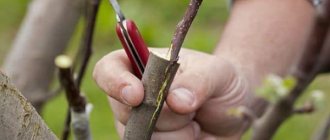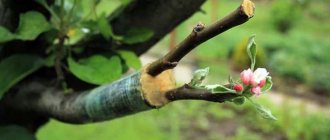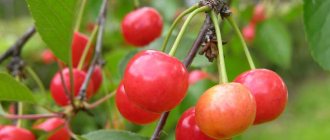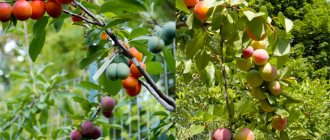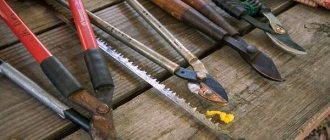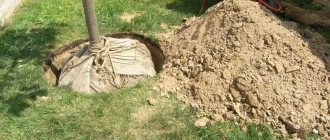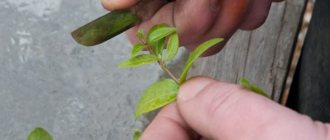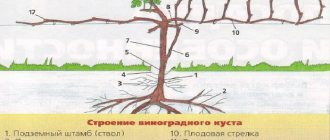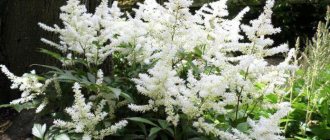What can cherry trees be grafted onto: names of trees
Planting fruit trees, regular care, and caring for the orchard are carried out in order to obtain a rich harvest of tasty and high-quality fruits. But what a disappointment it can be when the cherry fruits turn out to be of unsatisfactory quality. Inexperienced gardeners come up with the idea of uprooting trees and planting new seedlings in their place.
Experienced gardeners, in turn, will not rush to destroy the garden. There are a number of reasons for this:
- It is not a fact that newly planted seedlings will bear a good harvest.
- You will have to wait about 5 years for the first fruiting of young trees.
There is a way that will help revive cherries, and it will be possible to collect good fruits from a seemingly hopeless tree in 1-3 years. This is a tree graft.
Grafting is a method of vegetative propagation of trees. In simple words, this is the transplantation of part of a tree of one type to another. As a result of grafting, two parts of different trees grow together into one, thereby improving the quality of the fruit.
Grafting is carried out, first of all, to improve the quality of the fruit. There are also other advantages to tree grafting:
- Increasing frost resistance, which is very important for cherries that are demanding on climatic conditions.
- Increasing disease resistance.
- Extending the life of an old garden.
- Reproduction of trees without uprooting.
Tree grafting is done to improve the quality of the fruit.
Before grafting cherries, you need to decide on a tree for the rootstock. Cherry is successfully grafted onto the following trees:
- Cherries on cherries . This grafting is carried out to improve the taste of the fruit. If you don’t like the taste of cherry fruits, graft a cutting of a more tasty and good variety onto it. It will be possible to harvest in just 1 year.
- Cherry on cherry plum . Stone fruit trees, including cherries, are often grafted onto cherry plums. This grafting will help make the branches of the cherry tree stronger and improve the vitality of the cherry tree in conditions of nearby groundwater.
- Cherry on cherry . Two related trees get along well with each other. Such a rootstock will make cherries more resistant to the climatic conditions of the region with cold winters.
- Cherry on plum . Such experience is within the capabilities of gardening professionals. If the grafting is successful, you will get an interesting tree with different types of fruits.
Sweet cherry grafted onto cherry
General information about the vaccine
JSC Medicine uses the Russian-made drug Gam-COVID-Vac, better known under the commercial name Sputnik V. The vaccine was developed and produced by the National Center of Epidemiology. N. Gamaleya. This is a two-component vector-type drug, the production technology of which is well known and has been tested many times over the past decade. The basis is two types of harmless human adenovirus, the shells of which are supplemented with protein particles of the S-protein of the SARS-CoV-2 coronavirus. When the drug enters the human body, it causes an immune response, which consists of producing a sufficient amount of specific antibodies and forming stable immunity to COVID-19 infection.
What is the best time to graft cherries: timing
Important: The best time for vaccination is early spring, when active sap flow begins.
- If you decide to graft cherries in early spring , it is important to do it on time, since the favorable period for grafting is very short, literally 2 weeks. The air temperature at night should not fall below 0 degrees, and the buds should not yet bloom. Spring grafting is preferable for the reason that it is during this period that the probability of fusion of the cuttings with the rootstock is highest.
- Summer grafting is also practiced . Provided the procedure is carried out correctly, there is a high probability that the cutting will have time to take root before the onset of frost. The main condition for summer vaccination is cloudy weather, but without rain.
- Autumn grafting of cherries is also practiced, but the likelihood of the cuttings taking root is reduced. After all, it is impossible to predict when frosts will begin.
- Tree grafting is carried out even in winter , but is not suitable for cherries. Winter grafting is suitable for trees such as apple, plum, and pear.
What is the best method for grafting cherries?
If you decide to graft trees in your garden, you need to remember two terms:
The rootstock is the tree onto which the cutting will be grafted. These should be young trees adapted to the climatic conditions of the region. The best rootstock is considered to be a tree that is up to 10 years old. On such trees, fusion processes occur faster.
A scion is a shoot of a tree that will be planted on a rootstock. Sometimes a branch is grafted, but in most cases a cutting is used - part of a shoot with several buds.
There are many ways to graft trees. Let's consider the most suitable methods for cherries.
Copulation . This method involves combining a cutting with a tree trunk, and both parts must have the same diameter. As a result of attaching the cutting to the trunk, it turns out to be one whole. To do this, you need to make oblique cuts on the rootstock and scion, connect the two parts, then wrap tightly with electrical tape. With improved copulation, additional splits are made in the sections, which are then joined.
Methods of grafting cherries: copulation
Into the cleft . This method is suitable when the diameter of the tree trunk is significantly larger than the grafted cuttings. First, make an even cut on the rootstock. Then a split 4-5 cm deep is made in the center. After that, a cut cutting is inserted into the split. Both parts should fit snugly against each other. The grafting site is wrapped with electrical tape. Open sections are treated with garden varnish.
Methods of grafting cherries: in splits
For the bark . Trees can be grafted using the bark method when there is strong sap flow. The essence of this method is that the cutting is inserted into the cut bark of the rootstock. To do this, make an even, clean cut on the branch of the rootstock and clean it so that there are no unnecessary notches. Then a cut of several cm is made on the bark. An oblique cut is made on the cutting and carefully cleaned from all sides in one movement. The cutting is then inserted into the cut in the bark. Several cuttings are grafted onto one branch of the rootstock from different sides so that the wound heals better.
Methods of grafting cherries: behind the bark
The best way to learn grafting techniques is to see it. We invite you to watch a video that will help you learn how to properly plant cherries.
Compatible plants that can be grafted
Many gardeners are interested in the question: what crops are compatible for grafting, what can be used for rootstock and scion? You can always use the same types of plants, but different varieties. This is done to obtain, change or improve varietal characteristics.
You will probably be interested in an article about grafting apple trees and other fruit trees, which describes in detail the procedure, the tool used, and the means for processing.
You can also experiment with different types of fruit trees, but it should be taken into account that some plants react quite aggressively to the engraftment of any cuttings, while others are capable of even taking on a different species.
Compatibility table for scions and rootstocks of fruit crops
Most often, grafting of fruit crops in the garden is used to rejuvenate a variety or replace it with a more valuable one. If you want to get a completely different plant in the shortest possible time, you can use a scion of a different type. For example, in the place of an apple tree, a pear or cotoneaster will take root well, and chokeberry will easily accept red rowan.
Grafting fruit trees with bark cuttings
Cuttings are used to graft fruit trees in the garden. If the rootstock is young and its diameter coincides with the scion, then it is better to use improved copulation (with a gap). When the tree is old enough, grafting into a split or behind the bark is suitable.
Is it possible to leave 3 grafted cherry cuttings?
When grafting, from two to 4 cuttings are placed on the branches of the rootstock, as in the photo.
Grafted cuttings
This ensures uniform overgrowth of the cut. When the cuttings grow 15 cm, the weakest ones should be pinched. After 2-3 years, when the cuttings take root completely, choose one - the most developed cutting. The rest are removed so that overgrown branches do not interfere with each other.
In the next video you can get acquainted and master the technique of grafting trees by bark.
Rootstock requirements
The rootstock is the basis for grafting. It is the rootstock that will subsequently feed the grafted tree; how winter-hardy and disease-resistant the plant will be depends on the rootstock. Rootstocks can be cultivated or wild, low-growing or vigorous. They are obtained by vegetative or generative propagation.
- Caring for currants after harvest
Before choosing a rootstock, you must know exactly what goal you are pursuing so that your expectations are likely to be met. It is desirable that the rootstock has such qualities as cold resistance, drought resistance, has well-developed roots and is adapted to your area.
How to prepare cuttings?
For grafting, cuttings should be prepared in advance. Cuttings are harvested in the fall, before the onset of frost. Then they are stored all winter in appropriate conditions, and in the spring they are grafted.
The cutting length should be 35-40 cm, diameter 5 cm. These should be annual shoots with apical and lateral growth buds. The cuttings are tied into a bundle and stored either in the snow or in the basement in sawdust or sand. You can also store the cuttings in the refrigerator; to do this, they are wrapped in a damp cloth, wrapped in a bag and sent to the bottom shelf.
Grafting with fresh cuttings is also practiced, but they must be cut before the sap begins to flow. The success of grafting with such cuttings is reduced.
What else does the success of vaccination depend on:
- All cuts on cuttings and rootstock must be clean. To do this, it is recommended to trim the cuts of the rootstock and touch the cuts with your fingers as little as possible.
- Hands and tools must also be clean.
- The knife must be very sharp. The cut should be made with one movement of the knife. It is unacceptable to make irregularities, cracks, or jagged edges on the cuts.
- The grafts must be tied tightly, and the cuttings must not be moved after grafting.
- The grafting procedure should be carried out quickly so that the sections do not become weathered.
- Open cuts should be covered with garden varnish.
- Use only healthy and young trees as a rootstock.
After 2-3 weeks it will be possible to check whether the cutting is taking root. Shoots from the buds appear on the established cuttings. At this time, you should be especially careful about the tree:
- Check for pests. If they appear, take immediate action.
- Throughout the season, shoots that appear on the rootstock below the grafted cuttings must be removed.
- A grafted tree needs feeding and sufficient watering.
The result of successful rooting of the cuttings
Grafting cherries onto plums: advantages and disadvantages
Grafting cherries onto plums is not the best option. The fusion of cherry and plum wood occurs with great difficulty, and most often the result of the experiment is unsuccessful. As a result, you can waste your time and energy and get nothing in return.
However, experienced gardeners manage to graft cherries onto plums. If the experiment is successful, the result is a “miracle tree” on which different fruits grow. This can save space in your garden, which is usually limited to a few acres.
Grafting of cherries onto plums is carried out in most cases when there is nothing else to graft on. Try it, maybe you will succeed.
Cherry grafting is an interesting experiment, the success of which depends on many factors. Grafting cherry trees should be taken seriously; it is very important to comply with all requirements for tools, timing of grafting, cleanliness of cuts and care of the tree after grafting. Then the result of your work will be able to bear fruit in the truest sense of the word.
When will vaccination start?
Many people are interested in when vaccination against coronavirus will begin in Moscow. We hasten to please our patients: it already began in December 2021 and continues to this day. At the initial stage, the event was held only among certain categories of people - those who, due to the nature of their professional activities, cannot limit the number of their contacts, those who are sufficiently young and healthy, and have reached the age of majority. At the clinic of JSC "Medicine" you can get vaccinated against coronavirus in comfortable conditions. The service is available to all citizens of the Russian Federation. More details on the services page.
Currently, thanks to successfully completed trials, older people and patients with chronic diseases, i.e., those categories for whom COVID-19 infection poses the greatest danger, have gained access to immunization. So, if you're still waiting to get vaccinated against coronavirus, good news for you: you can get vaccinated right now.
